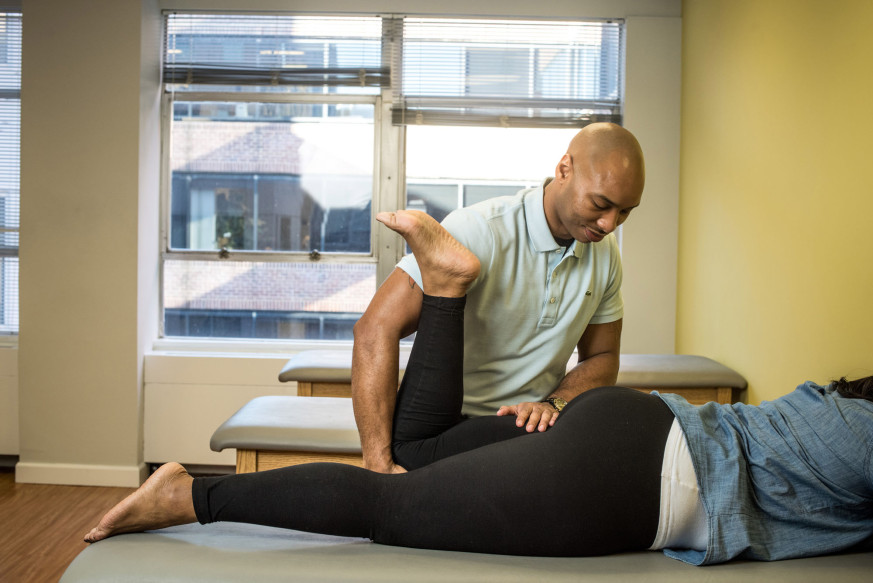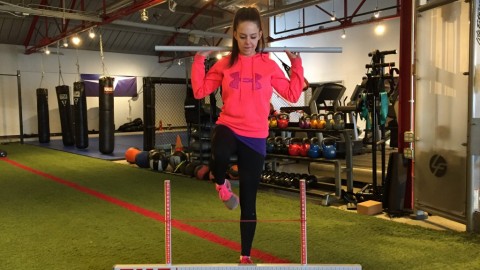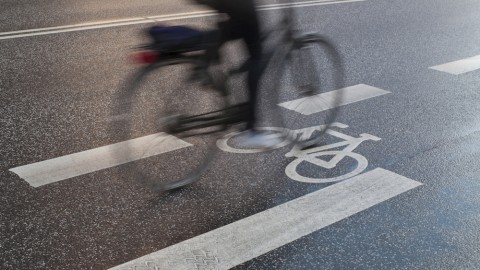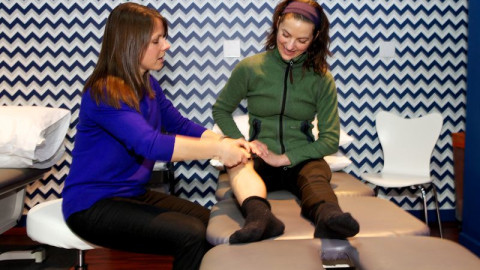Many patients who have never experienced physical therapy before think physical therapy is just exercise programs and hot and cold pack regimes. Although both of these can be utilized in a physical therapy treatment program, manual therapy is proven to reduce recovery times* and increase a patient’s range of motion and strength.
What is Manual Therapy?
Manual therapy is the use of a physical therapist’s hands to relieve pain and restore mobility. Manual therapy includes kneading and manipulating soft tissue such as muscles—which can increase circulation, reduce scar tissue and relax muscles—ultimately helping to reduce pain. Manual therapy can also include joint mobilization and manipulation, where the physical therapist uses measured movements at different speeds and forces to move bones and joints. This loosens tight tissue around joints and helps with flexibility, mobility, and pain. Manual therapy is typically used in conjunction with an individualized exercise program to restore function in the treated area.
Five Techniques Used in Manual Therapy
- Joint mobilization: Often, pulled muscles are actually muscle spasms formed in response to a restricted joint. The treatment of ice and rest is ineffective for this condition because it doesn’t get to the root of the problem. Joint mobilization is needed to loosen up the joint and improve its range of motion by slowly and painlessly moving the joint in ways that the patient is unable themselves.
- Soft Tissue Mobilization (STM) / Myofasical Release (MYR): While muscle tension is usually reduced when joint motion improves, the muscle spasm will often remain. Soft tissue mobilization addresses muscle tension by moving tissue fluids, reducing tension, and breaking up fibrous or inelastic tissue such as scar tissue (also known as “myofascial adhesions”), through repetitive stretching and pressure. Your physical therapist will use a variety of techniques to reduce pain associated with the spasm, such as the Graston Technique. Myofasical release is similar to STM but it involves a larger area of issue.
- Strain-Counterstrain: With this technique, the physical therapist will place the position in a position where they are experiencing the least pain for a couple minutes, while applying mild stretching. The patient is slowly brought out of the position, allowing the body to restore the muscles to their normal tension. This technique is suitable for those who are suffering from acute pain because the patient will be placed in his most comfortable position.
- Muscle Energy Techniques (METs): Muscle energy techniques are used to lengthen shortened muscles and mobilize restricted joints. Unlike other manual therapy techniques, METs are an active technique, meaning the patient contributes. The patient contracts their muscles for several seconds against a counterforce precisely applied by the physical therapist. This is repeated as the joint’s range of motion increases but does not stress the joint.
- High Velocity, Low Amplitude Thrusting: This procedure allows joints to open and close properly. It involves taking the joint almost to the end of its range of motion, and thrusting (about 1/8 of an inch) to the end of the joint’s range of motion. It is more aggressive than joint mobilizations and METs, but it does not move the joint beyond its anatomical limit and so does not increase pain or damage the joint.
Manual Therapy Sounds Like It Hurts
Manual therapy doesn’t have to hurt, although there is often some discomfort inherent in the process since physical therapists are actively manipulating a painful or tight area. Before beginning manual therapy, physical therapists will have a consultation with the patient to understand their unique condition and baseline their current range of motion, strength and flexibility. Physical therapists will modify the amount of force they use depending on the injury and if the pain is chronic, acute, or post-surgical. After treatment, patients may experience some soreness for a day or two, but usually report an immediate increase in range of motion and reduced pain levels.
Is It Just An Expensive Massage?
Manual therapy may sound like a massage; however, while a massage aims to relieve tension in general, manual therapy is a therapeutic treatment for a specific condition performed by a certified physical therapist who has an intricate knowledge of the human body. Exercise isn’t a replacement for manual therapy either. While exercise is a valuable part of physical therapy, studies have shown* that the use of manual therapy in addition to exercise is more effective than either treatment on its own.
Sounds great, but does it work for me?
Any painful or stiff joint can be treated with manual therapy. There are no limitations on the joints that can be treated and manual therapy can be used to treat your spine, shoulder, elbow, wrist, hip, knee, and ankle.
At Therapydia, we work with every patient to customize a treatment program and use manual therapy, along with other physical therapy techniques, to help patients recover for the long run. Feeling pain? Contact us and learn how we can help you return to your favorite activities.
*Manual Therapy Studies:
1. Bang M, Deyle G. Comparison of Supervised Exercise with and without Manual Physical Therapy for Patients with Shoulder Impingement Syndrome. Journal of Orthopaedic & Sports Physical Therapy 2000; 30: 126-137.
2. Niemisto L, Lahtinen-Suopanki T, Rissanen P, Lindgren K, Sarna S, Hurri H. A Randomized Trial of Combined Manipulation, Stabilizing Exercises, and Physician Consultation Compared to Physician Consultation Alone for Chronic Low Back Pain. Spine 2003; 28: 2185-91.









